

WTTC: Shanghai is largest tourism market in the world
Today, the World Travel & Tourism Council (WTTC) released its annual Cities Report at the WTTC Asia Leaders Forum in Macau, SAR. The Report covers 72 of the world’s most important tourism cities, which together generated over $625bn contribution to GDP last year (24.3% of global Travel & Tourism GDP).
The world’s top ten cities in terms of tourism market size are: Shanghai (US$35bn), Beijing ($32.5bn), Paris ($28bn), Orlando ($24.8bn), New York ($24.8bn), Tokyo ($21.7bn), Bangkok ($21.3bn), Mexico City ($19.7bn), Las Vegas ($19.5bn) and Shenzhen ($19bn).
The world’s top ten cities in terms of job creation are: Jakarta, Beijing, Mexico City, Shanghai, Bangkok, Chongqing, Delhi, Mumbai, Ho Chi Minh City, Shenzhen.
WTTC President & CEO Gloria Guevara commented, “With 54% of the world’s population living in urban areas, cities have become global economic hubs, driving growth and innovation. They attract huge quantities of people who travel to experience their culture, do business, and live. This growth has also resulted in a rise in city tourism – a trend which is forecasted to maintain momentum.
“Our Report highlights the crucial importance of cities to Travel & Tourism worldwide, and likewise how vital this sector is to the economy. Over half a billion trips are made to cities annually representing 45% of global international travel.”
Highlights from the Report include:
· Cairo was the fastest growing city in 2017 in terms of Travel & Tourism GDP contribution (34.4%), followed by Macau (14.2%).
· Four of the five fastest growing cities over the past ten years are located in China: Chongqing, Chengdu, Shanghai, Guangzhou.
· Shanghai is ranked as the largest city by Travel & Tourism volume in 2017. By 2027, Shanghai is expected to be double the size of Paris in terms of Travel & Tourism’s direct contribution to GDP.
· Bangkok (50.4%), Paris (29.8%), Mexico City (24.0%) and Tokyo (20.2%) are the biggest contributors to their country’s Travel & Tourism GDP.
· In terms of domestic vs. international spend, New York sets an example as a city with a remarkable balance (52.7% vs. 47.2%). Meanwhile, Paris relies heavily on international spend and Beijing on domestic.
China markets driving growth
Of particular note, Chinese cities have matured rapidly over the past decade, and are forecast to continue dominating the growth charts between 2017 and 2027. Shanghai, for example, went from being the 8th largest city in terms of Travel & Tourism GDP in 2007 to become the largest in 2017 – a position it is expected to maintain until 2027. Meanwhile, the rapid growth of Guangzhou will take it to 4th place, and Chongqing is forecast to join the top 15 for the first time. This comes following a period of sustained infrastructure development, including investments in airports and extensive product development.
The Chinese domestic and outbound markets will drive growth in the coming decade, with the majority of top performers maintaining their positions. Chinese cities will continue to lead, although a slowdown in growth is expected. With the exception of Marrakech, the cities in the top ten ranking of fastest growing Travel & Tourism GDP in the coming decade are in Asia-Pacific.
Guevara continued, “With such good performance of cities around the world, and the supreme growth experienced by cities in Travel & Tourism, comes huge opportunities. This Report illustrates the strength of Travel & Tourism and its economic impact not only at a macro-level but at the grassroots where it is relied upon every day. A vibrant tourism sector can stimulate investment, preserve and promote cultural heritage, and catalyse new activities such as research, technology or the creative economy.
“Planning for and managing growth so that it is inclusive and sustainable – with the well-being of the communities who live and work in such cities at its core – needs to be the top priority for city governments, working in partnership with the private sector.”
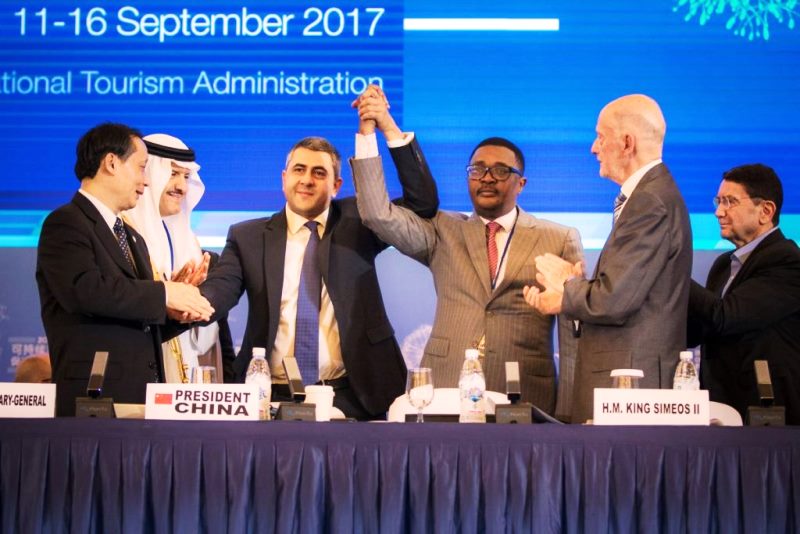
Battling Cancer and let down by World Tourism
What happened to Dr. Walter Mzembi, former minister of Tourism and Hospitality for Zimbabwe, and former candidate for UNWTO Secretary-General? Dr. Mzembi is currently getting medical treatment battling cancer in South Africa and is frustrated. He is trying to understand where the African tourism family is when one of its own is being persecuted?
There are many indications Dr. Mzembi is being harassed while we all watch.
They have persecuted him for nearly a year now, on some incomprehensible criminal charges brought up by the new government in Zimbabwe.
Such charges touch on the integrity of the UNWTO itself. It’s a seemingly sophisticated witch hunt meant to discredit his legacy with the UNWTO, where he with distinction led the Commission for Africa from 2013 to 2017 for two consecutive terms.
Mzembi set the agenda for continental tourism policy formulation. His successor Najib Balala, minister of tourism from Kenya acknowledged his legacy at the last UNWTO Commission of Africa Meeting in which Africa reaffirmed its support for his candidature for the post of UNWTO Secretary-General position.
Dr. Mzembi honorably lost this election by a two-country margin on behalf of Africa. Where is Africa when one of its own is being persecuted
 The prosecution or better persecution of such a distinguished African citizen is a negative exercise for global tourism, it’s negative for Africa and specifically Zimbabwe.
The prosecution or better persecution of such a distinguished African citizen is a negative exercise for global tourism, it’s negative for Africa and specifically Zimbabwe.
Dr. Mzembi is a resource that any Government and Africa should exploit to its advantage.
How do you reconcile this with the way the new dispensation in Zimbabwe is treating Walter Mzembi?
Did they forgot his work co-hosting the 20th session UNWTO General Assembly at Victoria Falls in what was described by then Secretary-General Taleb Rifai as the “best ever and most attended General Assembly in the history of General Assemblies”
Walter Mzembi brought the global tourism family attending the UNWTO General Assembly in Chengdu, China to a five-hour gridlock insisting on the procedure on the affirmation of the new Secretary General. It ended with him compromising and giving his concession speech din with humility he congratulating his rival, the current UNWTO Secretary-General Zurab Pololikashvili.
Former Minister Mzembi and for a decade steered Zimbabwe through the most difficult period and got many endorsements for his country. He has been seen as a true patriot that it makes us wonder why such good deeds could be so easily forgotten on the expediency of a new dispensation in Zimbabwe.

Perhaps Dr. Mzembi has a point when he asked eTurboNews: “Where is the international tourism family when one of its own is being persecuted?”
Click here to read the letter of acknowledgment by the Zimbabwe government
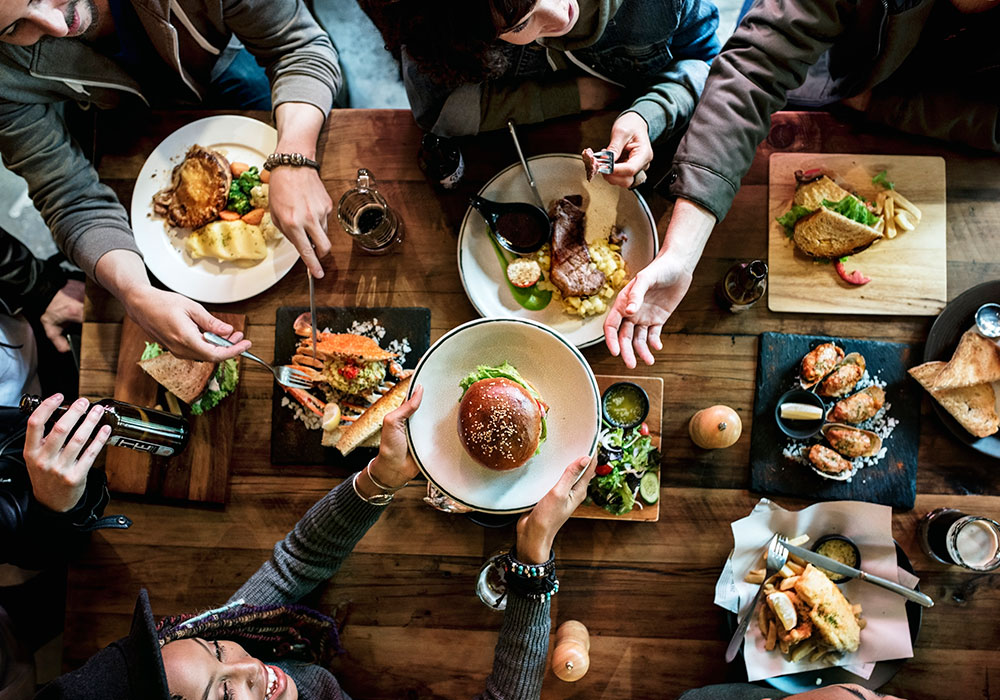
First global Gastronomy Tourism Startup Competition launched
The World Tourism Organization and Basque Culinary Center (BCC), have launched a pioneering initiative for the gastronomic tourism sector, with a global call for startups or companies, mature or emerging, technological and non-technological, with innovative ideas capable of revolutionizing and integrating gastronomy in tourism and inspiring tourists with new ways and reasons to travel.
The gastronomic tourism sector is moving towards innovation and the diversification of its offerings. UNWTO, in collaboration with its Affiliated Member, Basque Culinary Center (BCC), has launched the 1st UNWTO Gastronomy Tourism Startup Competition, the first and largest initiative in the world dedicated to identifying new companies that will lead the transformation of the gastronomic tourism sector.
Intangible cultural heritage has become the decisive factor that attracts and captivates tourists. Gastronomy tourism, as a component and vehicle of culture and tradition, is an indispensable resource that adds value and provides solutions for destinations that seek to stand out through unique product offerings.
The Competition will make it possible to identify the best solutions and projects that contribute the most to the sector through pioneering proposals in the implementation of emerging and disruptive technologies, as well as emerging companies or startups. It aims to identify challenges and projects, and to catalyse innovations that can transform the Gastronomy Tourism sector in the near future.
“Innovation and tourism investments are not ends in themselves, but are means to promote better tourism products, improve tourism governance and harness its proven capability to foster sustainability, create jobs and generate opportunities,” said UNWTO Secretary-General, Zurab Pololikashvili.
“Education and innovation are essential for the development of sustainable gastronomic tourism. At Basque Culinary Center, we support entrepreneurship and the development of new business projects to ensure the future of the sector. In this regard, we are proud to once again team up with our partners at UNWTO in order to continue fostering entrepreneurship and innovation linked to gastronomy tourism through this initiative,” said Joxe Mari Aizega, General Manager of Basque Culinary Center.
UNWTO and Basque Culinary Center have entrusted the process of finding startups to BCC Innovation through its Culinary Action! programme, which has accelerated nearly 50 startups by providing innovative, sustainable and high added value solutions to the gastronomy value chain.
Sustainability and technology
Startups are invited to pitch business models that are related to sustainability, respect the value chain, offer an authentic and coherent narrative, and add value to cultural and local heritage.
The winners of this competition will have the opportunity to present their projects at the 5th World Forum on Gastronomy Tourism (2-3 May 2019, San Sebastián, Spain), with the possibility of receiving personalized consulting and mentoring from the BCC experts of project accelerator Culinary Action!
Full information on the terms and conditions are available here.
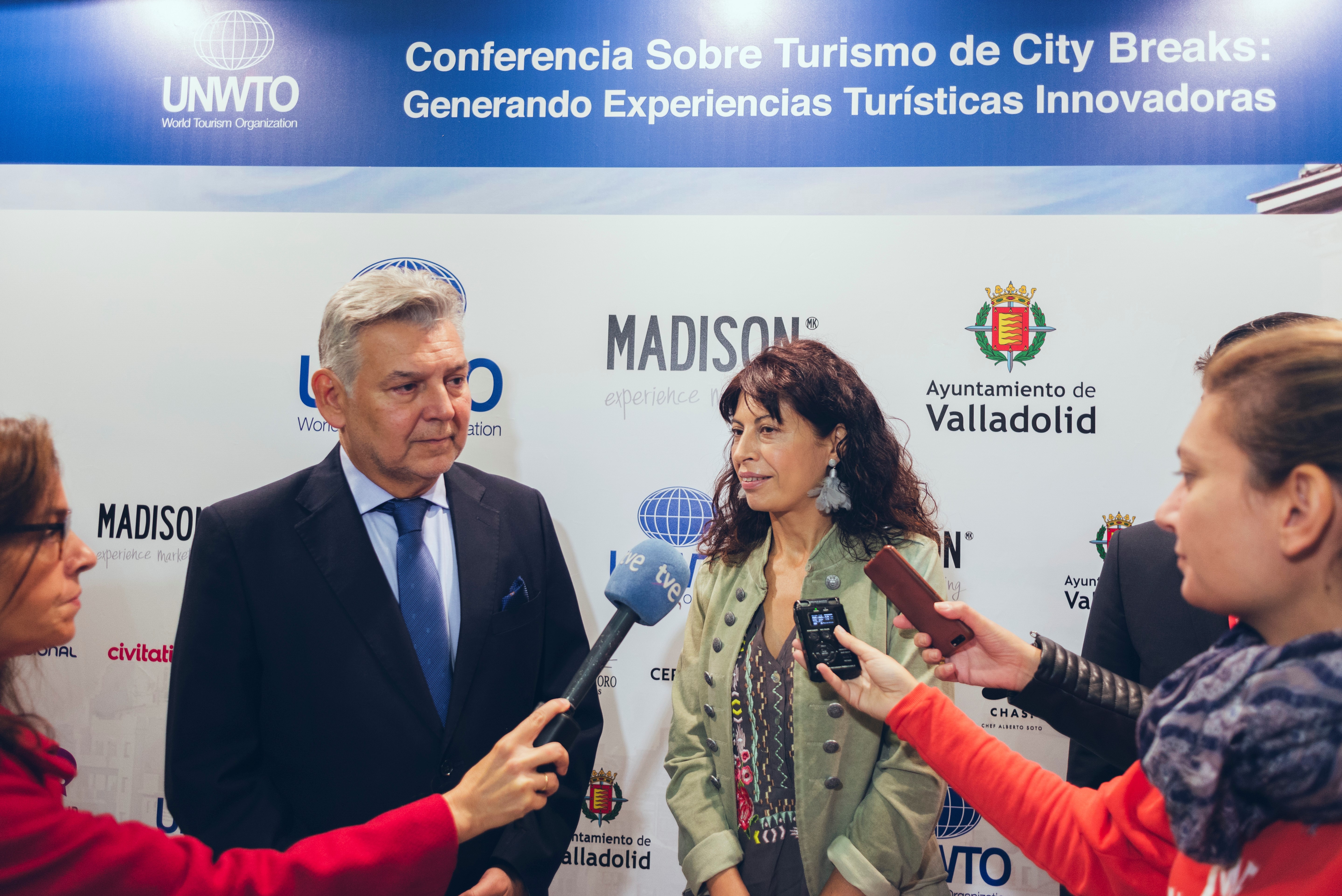
Creating Smart Cities for Innovative Tourism Experiences
The UNWTO Conference on City Breaks: Creating Innovative Tourism Experiences (15-16 October 2018) concluded today in Valladolid, Spain, with a call for cities to become smart tourism destinations, where tourism governance and the digital economy mesh together to offer travellers diverse and authentic experiences.
The conference brought together tourism leaders from the public and private sectors to analyse how to respond to the growing trend of city breaks as leisure experiences. They concluded that public-private partnerships, the inclusion of local communities and the creation of smart destinations are crucial for urban destinations to gain the knowledge and define the policies they need in order to respond to the new demands of hyper-connected and hyper-informed tourists.
“We must understand the evolution of tourists towards greater sustainability and inclusiveness, using new technological tools,” said Jaime Cabal, Deputy Secretary-General of the World Tourism Organization (UNWTO). “Creativity and innovation are needed when designing the experiences they are increasingly demanding.”
The Councillor for Culture and Tourism of Valladolid, Ana Maria Redondo, echoed this call, adding: “We need a better understanding of the fundamentals behind the current demand for city break experiences. Smart destination tools are our means to obtain this knowledge.”
The Deputy Director-General for Tourism Development and Sustainability of the Ministry of Tourism of Spain, Ruben Lopez Pulido, suggested that cities and all destinations change their models of tourism development to respond not only the most demanding tourists, but also to the rise of the digital and knowledge economy. “Being a smart destination is not just a label, but a process towards the comprehensive transformation of destinations, while always aiming at the achievement of the Sustainable Development Goals,” he said.
Speakers at the conference included Dieter Hardt-Stremayr, President of European Cities Marketing and CEO of the Graz Tourism Office in Austria, who described what he considered key challenges for the growth of city breaks: transportation issues, seasonality, and the dispersion of tourism demand within a city and over time. “Our main challenge is to attract visitors to come right at this moment. To overcome it destination managers should focus on parts of the tourism offer that are ‘temporary’,” he concluded.
The main conclusions of the conference referred to urban tourism governance models. Participants highlighted that, with the growth of high-speed, low-cost transportation links that provide more and more visitors with access to city breaks, city destinations must respond by prioritizing investments that benefit residents and tourists alike.
They also concluded that with the technological advances that allow the creation of smart destinations, destination management organizations must shift their focus from only promoting the experiences available for tourists in cities, to managing urban tourism in all its complexity. For their part, tourism policy makers should use smart destination tools to study the impact of tourism on the profitability and sustainability of a city, and place the destination at the centre of policy changes. These conclusions will be taken into account in the UNWTO work plan on urban tourism.
The Conference was organized by the UNWTO in collaboration with the City Council of Valladolid and the marketing agency MADISON, an Affiliate Member of the UNWTO. Other speakers included representatives from Madrid Destino, San Sebastián Turismo & Convention Bureau, Ljubljana Tourist Board, Turin Convention Bureau, Lisbon Tourism Observatory, Municipality of Alba lulia (Romania), Google, TripAdvisor, Basque Culinary Center, World Heritage Cities of Spain, AMFHORT, European Historical Association of Thermal Cities, Innova Tax Free, Thyssen-Bornemisza Museum, Thinking Heads, Segittur, Civitatis, Authenticitys and Amadeus, as well as journalists Xavier Canalis of Hosteltur and Paco Nadal of El Viajero (El País newspaper).
International arrivals into Asia Pacific continue to exceed the global average
Foreign arrivals into Asia Pacific destinations continued to grow at better than the global average in 2017, reaching a record volume high of more than 646 million arrivals relative to 2016.
According to the Annual Travel Monitor 2018 Final Edition (ATM) released by the Pacific Asia Travel Association (PATA) today, international visitor arrivals (IVAs) into 47 destinations in Asia Pacific covered in this report increased by 5.7 percent and added close to 35 million additional arrivals to the collective foreign inbound count into Asia Pacific in 2017.
In percentage increase terms between 2016 and 2017, the Pacific had the strongest annual increase at 5.9% year-on-year, followed by the Americas at 5.8%, while Asia kept pace with the Asia Pacific average of 5.7%.
By annual increase in the absolute volume of foreign arrivals however, these positions were reversed with Asia receiving close to 25 million additional foreign arrivals between 2016 and 2017, followed by the Americas with a gain of almost 8.6 million and the Pacific with around 1.4 million additional foreign arrivals received over that period.
Within the Americas, Central America showed the strongest incremental increase in foreign arrivals between 2016 and 2017, capturing 50.5% of the 8.577 million increase into the Americas over that period.
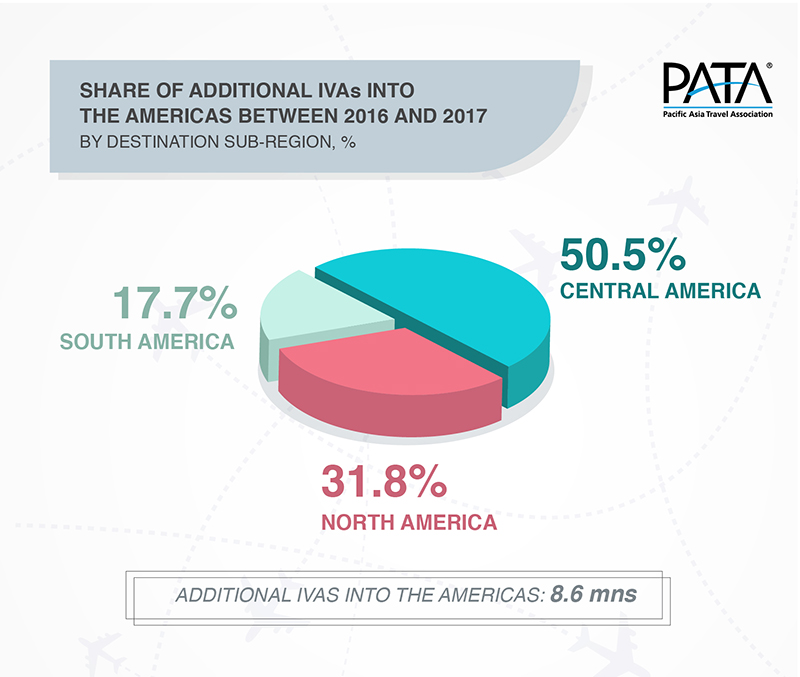
Across Asia it was Southeast and West Asia that each captured the largest proportion of additional foreign arrivals into Asia between 2016 and 2017.
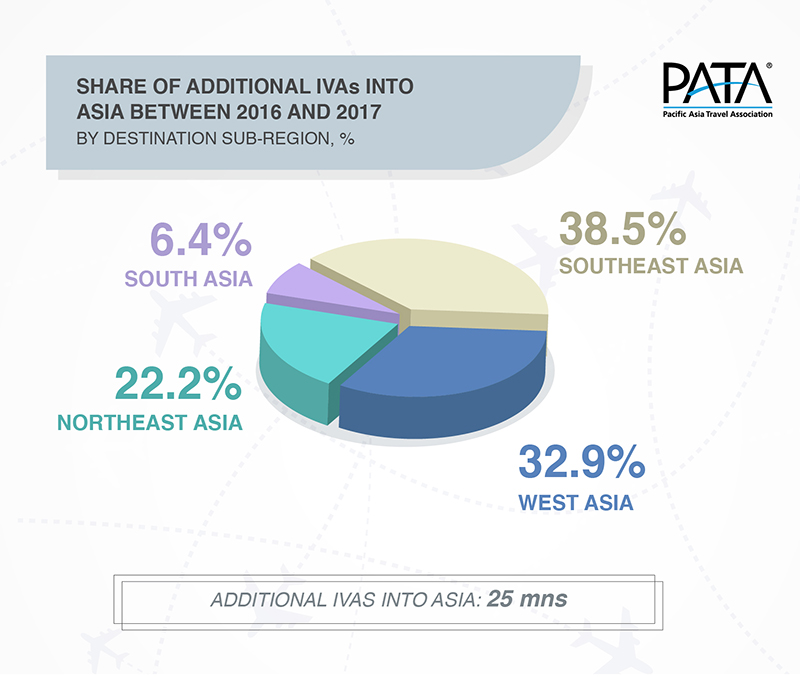
While in the Pacific, Oceania received more than half of the additional foreign arrivals into the region, followed by Polynesia.
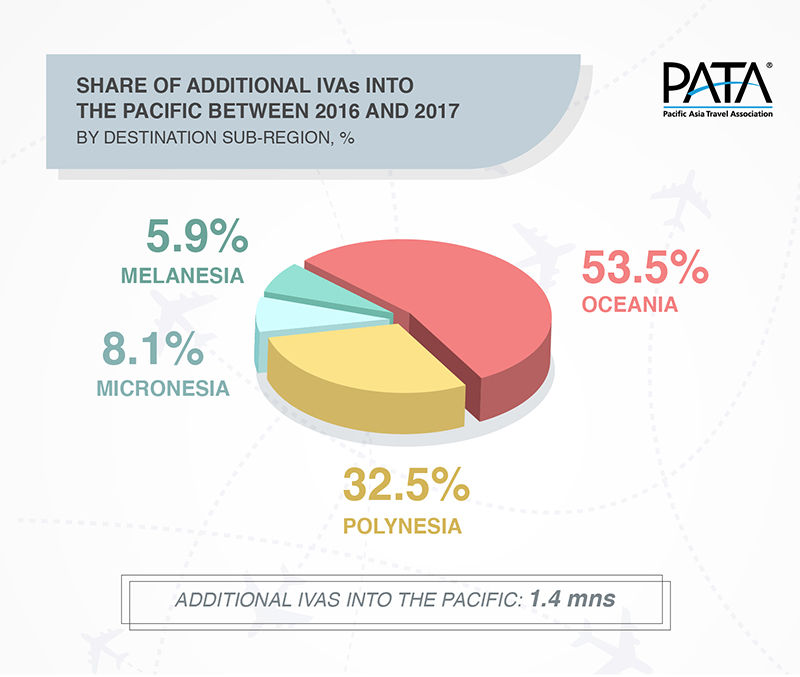
At the individual Asia Pacific destination level, destinations with the strongest annual percentage growth rates in 2017 ranked as:
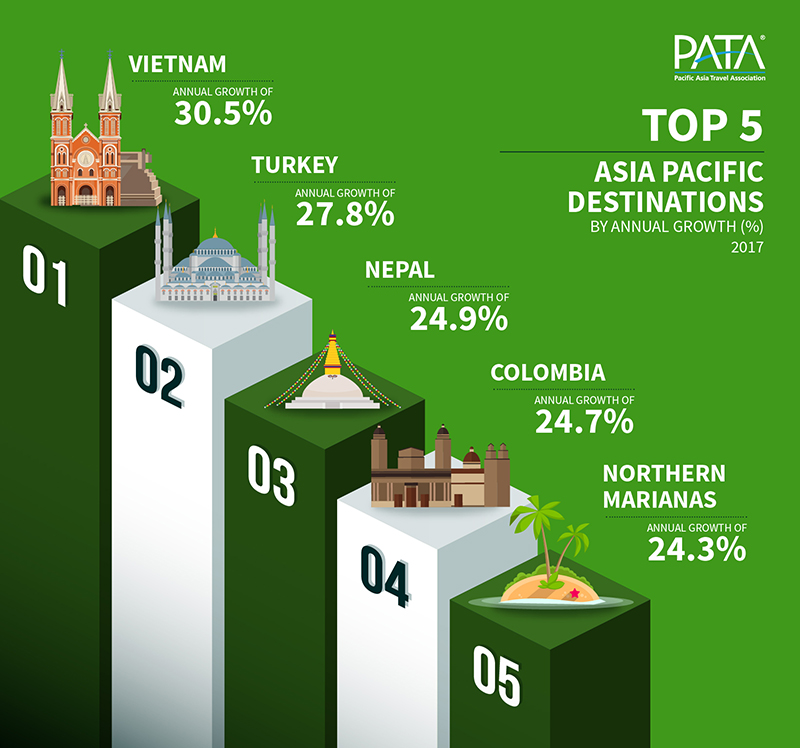
All told more than 40% of the 47 destinations covered in this report had annual growth rates in excess of 10%; another 28% had annual growth rates in excess of five percent.
For sheer annual volume increase between 2016 and 2017, the strongest Asia Pacific performers were ranked as:
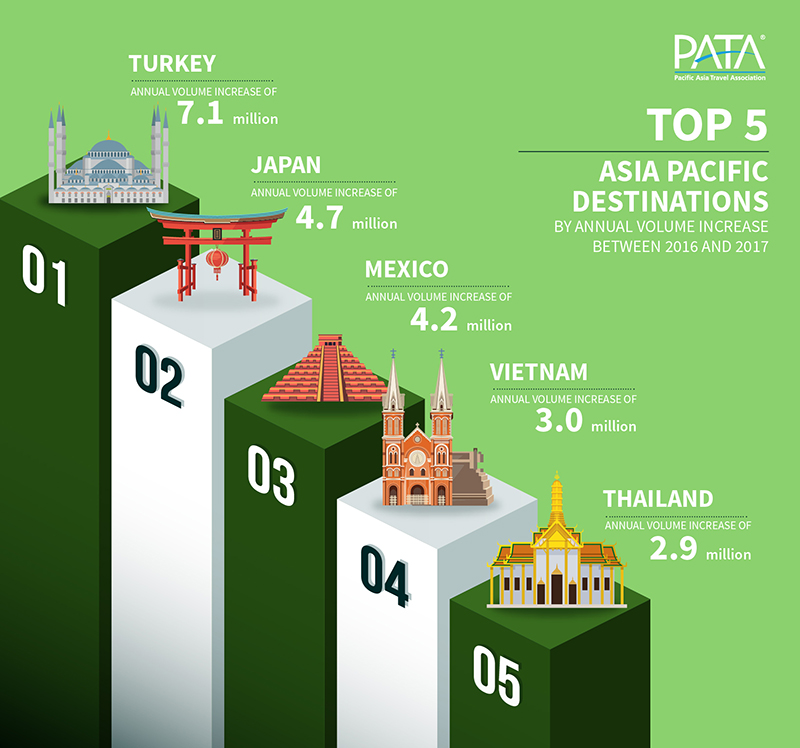
Of the destinations covered in this report, more than a quarter had annual volume increases of more than one million each, while close to 15% had between half a million and one million apiece.
The strong collective performance of Asia Pacific destinations in 2017 appears to be continuing into 2018 as well. As Dr. Mario Hardy, the CEO of PATA pointed out, “Early results for 2018 show a collective annual increase in foreign arrivals into Asia Pacific destinations of 8.7%, adding more than 25 million additional arrivals to the total inbound count during the first periods of 2018 relative to the same period of last year.”
Thirty-six Asia Pacific destinations had released year-to-date 2018 data on foreign arrivals at the time of preparing the Annual Tourism Monitor for 2018 and these are covered in some detail through the body of the report.
The strongest early performances are seen in a number of destinations including:
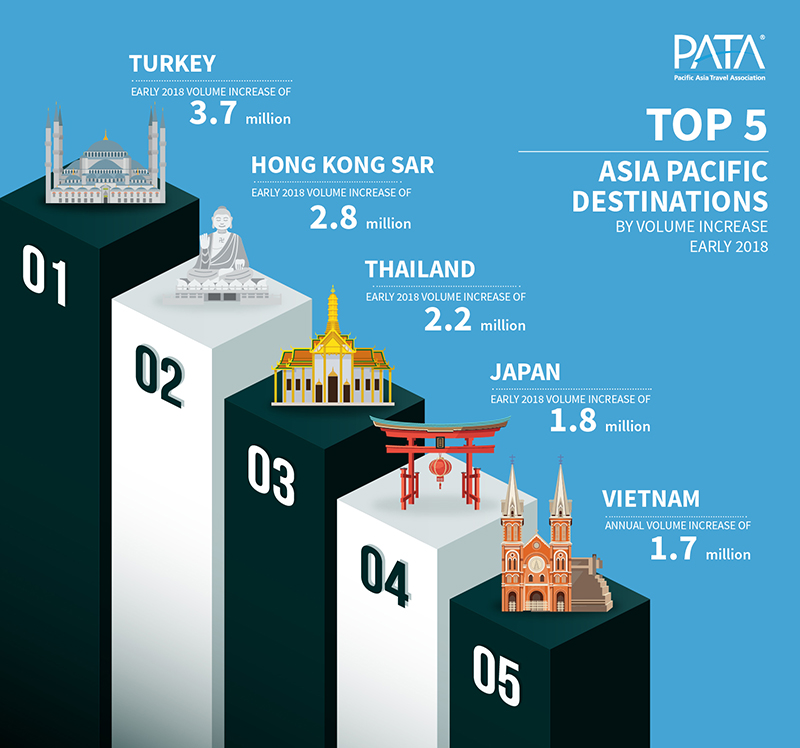
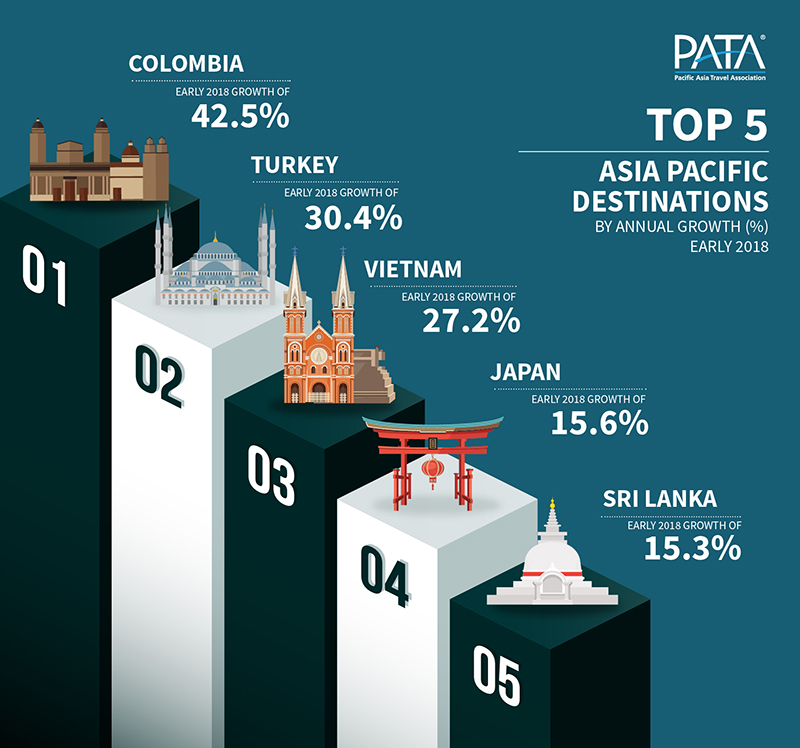
Furthermore, one quarter of these destinations had already posted volume increases of more than one million foreign arrivals in early 2018, relative to the same periods of 2017. Included amongst these are:
“In general terms, the volume of foreign arrivals into most Asia Pacific destinations now needs to be managed in terms of distribution across the destination, especially with growth rates remaining relatively high,” adds Dr. Hardy. “This includes shifting our focus from just the volume of arrivals to other performance metrics including length of stay and yield as primary indicators, along with developing a better and deeper understanding impacts of tourism on the environment and society at all levels, especially if we as a responsible economic sector wish to remain sustainable and therefore viable into the future.”
“It is not only the international travel flows that have an impact either. The domestic demand for new travel experiences is gathering momentum in many destinations as well, and when coupled with international visitor flows, that creates a very powerful dynamic. It is incumbent on us all to ensure that we can properly harness and manage that power or else risk losing those very attributes that drive visitor interest in the first place.”
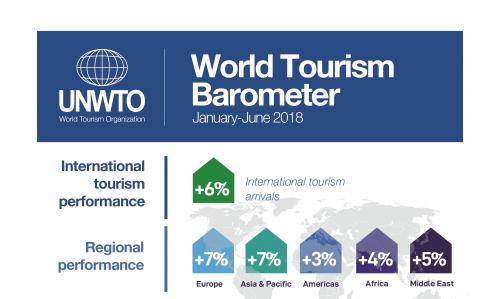
International Tourism Maintains Strong Momentum
According to the World Tourism Organization (UNWTO)’s latest barometer, international tourist arrivals grew 6% in the first six months of 2018 after a record year of growth in 2017.
All world regions enjoyed robust growth in tourist arrivals in January-June 2018. The increase was fuelled by strong demand from major source markets, supported by an upswing in the global economy. It comes after record year-round growth of 7% in 2017.
“Today’s release of international tourism data for the first half of 2018 serves as further proof of the sector’s resilience and relentless growth trajectory. We continue to work with our many partners to translate this growth into better jobs, more benefits to societies, and more opportunities for sustainable livelihoods and destinations”, said UNWTO Secretary-General Zurab Pololikashvili.
By region, Europe and Asia and the Pacific led growth with a 7% increase in arrivals each. Southern Mediterranean Europe and South-East Asia had the strongest results in these regions, both welcoming 9% more international tourists.
The Middle East and Africa also recorded sound results with arrivals growing at 5% and 4%, respectively, according to still-limited information available for destinations in these regions. The Americas saw 3% growth in arrivals over the six-month period, driven by South America (+7%) and North America (+5%). The United States continued to fuel much growth in the region and beyond.
On the demand side, France, the United Kingdom and the Russian Federation all reported double-digit increases in outbound spending in Europe. India and the Republic of Korea drove growth in Asia and the Pacific, while the world’s top source market China reported similar spending as in the same period last year.
Looking ahead
The first half of the year accounts for about 45% of annual international tourist arrivals. The second half represents 55% as it is three days longer and includes the Northern Hemisphere high-season months of July and August.
Against a strong first semester, growth prospects for the remainder of 2018 remain positive overall, though at a slower pace, according to the latest UNWTO Confidence Index survey. The Index value for May-August and expectations for September-December are somewhat lower than the Index value for January-April.
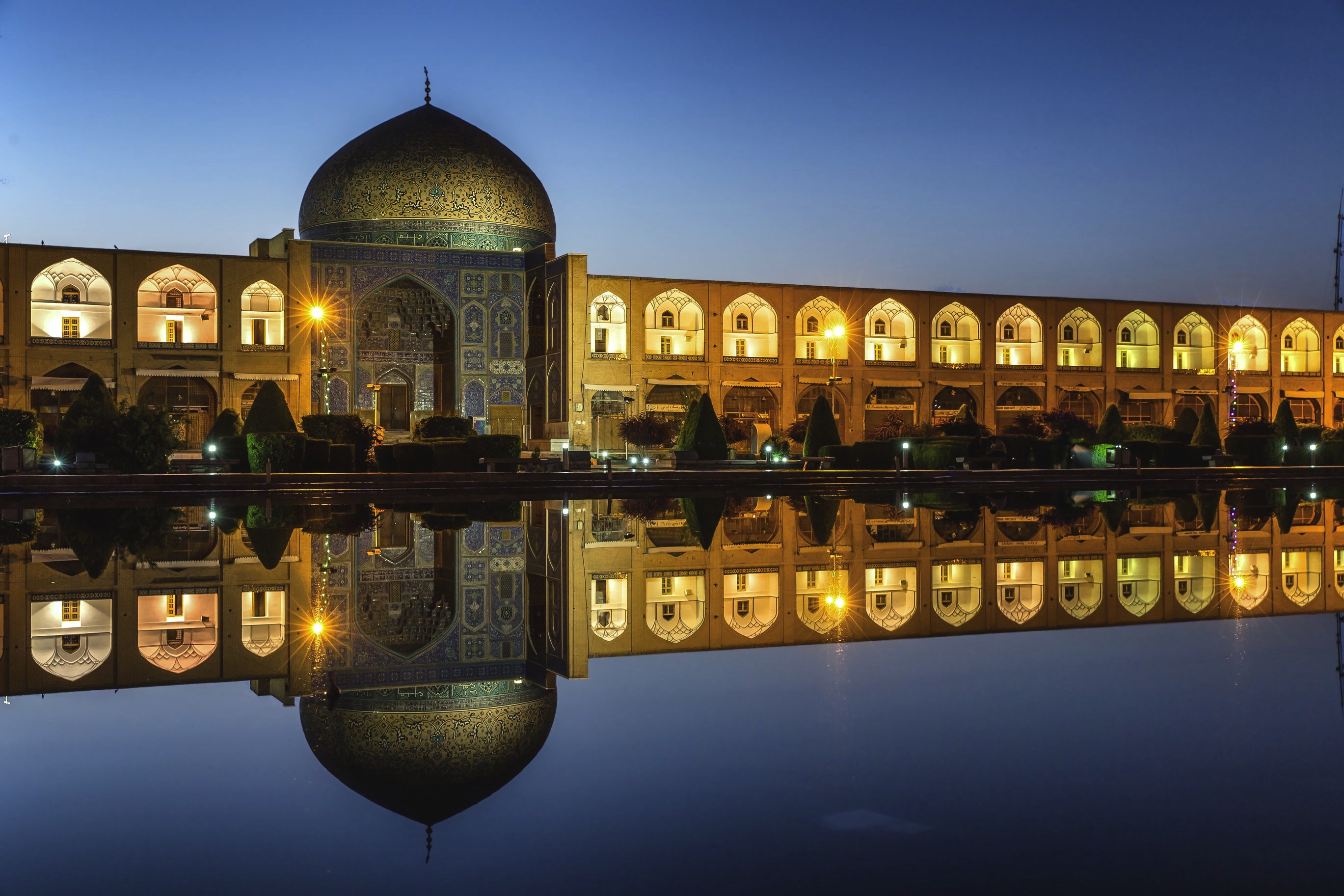
Technology and Innovation Seen as a Big Boost to Cultural Tourism
Seeking to advance use of innovation and cutting-edge technologies into cultural tourism practices, destinations and products, the International Seminar on Harnessing Cultural Tourism through Innovation and Technology will be held in Hamedan, Iran alongside the 40th UNWTO Affiliate Members Plenary Session (12-14 November 2018).
The seminar recognizes the significance of innovation in managing and promoting cultural tourism, which is one of the largest global tourism markets, and the opportunities of integrating innovative governance into the management of cultural tourism destinations. Through disrupting the sector and creating opportunities for improving governance, competitiveness and cultural resource preservation, innovation and technology are instrumental in enhancing cultural tourism development.
The seminar will feature three panels, exploring how big data, innovative business models, digital services and marketing, and other new technology can ensure long-term sustainability, profitability and competitiveness for cultural tourism products while preserving their authenticity. The keynote panel will explore how innovation and technology generate new opportunities for, and motivate new players to enter, the cultural tourism sector.
An estimated 4 out of 10 tourists choose their destination based on its cultural offering. The conference will explore how this choice is increasingly motivated by intangible factors such as a place’s culture, history, traditions and atmosphere, or its association with famous people, ideas or events.
Host city Hamedan, historically home to Iran’s famous scientists and poets, is nowadays known for its rich heritage of handicrafts, namely pottery design. The small town of Lalejin in Hamedan Province was designated the World Pottery Capital by the World Crafts Council on July 2016. Nearby Alisadr, the world’s largest water cave, is another renowned tourist attraction.
The seminar, which also spans the UNWTO Affiliate Members’ 40th plenary, is jointly organized by the World Tourism Organization (UNWTO), the Iran Cultural Heritage, Handcraft and Tourism Organization, and Alisadr Tourism Company.

WTTC welcomes Turismo de Portugal as new Destination Partner
The World Travel & Tourism Council (WTTC) today welcomes Luis Araújo, President, Turismo de Portugal, as our newest Member and Destination Partner.
Mr. Araújo joins peers from Visit California, NYC & Company, Las Vegas Convention & Visitor Authority, and Ras Al Khaimah Tourism Development Authority to become our fifth Destination Partner in five months. This announcement thus marks WTTC’s first formal alliance/affiliation with a Destination Partner based in Europe.
The Destination Partner membership category – our newest member classification – amplifies the voice of major National Tourism Organisations (NTOs) and Destination Management Organisations (DMOs) from across the globe, and will serve to tackle issues within the Travel & Tourism sector such as overcrowding and crisis preparedness.
WTTC’s partnership with Turismo de Portugal follows a hugely successful joint-event hosted in Lisbon this month. On 11 September, WTTC and Turismo Portugal welcomed over 150 CEOs, Ministers and industry leaders from across Europe at our inaugural Europe Leaders Forum, to discuss key issues affecting the region’s Travel & Tourism sector including travel facilitation, sustainable growth, and the future of work.
Luis Araújo serves as President of Turismo de Portugal, the country’s national authority responsible for the promotion and development of tourism. Mr. Araújo was appointed President of Turismo de Portugal in 2016 following a varied career in law and government both in Portugal and Latin America. In his current role, Mr. Araújo is responsible for promoting the Portuguese brand, attracting sector investments, and overseeing training provisions of Travel & Tourism workers in Portugal.
Gloria Guevara, President and CEO, WTTC, said, “I am so pleased to officially welcome Luis Araújo as a Member and Partner of WTTC.
“Portugal is a well-established destination with its Travel & Tourism sector boasting a growth rate that is three times faster than the country’s economy as a whole. Indeed, Portugal’s sector is healthy and growing. According to WTTC, in 2017, tourism contributed 17% to Portugal’s GDP and supported 1 in 5 of all jobs there.
“The inclusion of Turismo de Portugal as a Destination Partner helps to broaden WTTC’s representation of the global Travel & Tourism sector, allowing us to more effectively advocate for tourism actors and key issues worldwide.”
Luis Araújo commented, “I am delighted to formally join the WTTC as a Destination Partner, and am wholly confident that this newfound partnership will be a great one for tourism in Portugal, strengthening our travel network and knowledge-sharing opportunities. Our recent collaboration at the Europe Leaders Forum led to a dynamic, thoughtful, and truly special event, which makes me hopeful for our new partnership and future ventures.”
eTurboNews is a media partner for WTTC.
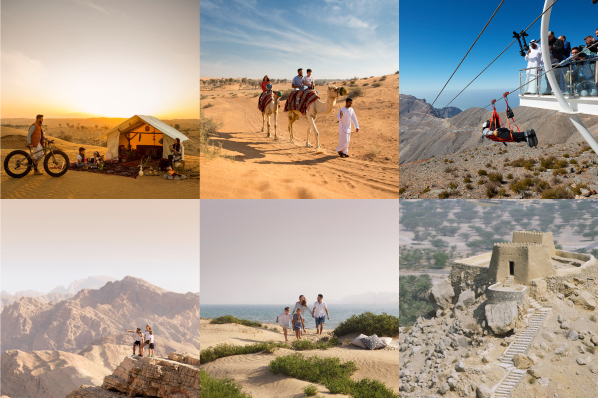
Ras Al Khaimah to host PATA Annual Summit 2020
BANGKOK, October 8, 2018 — The Pacific Asia Travel Association (PATA) is set to organise the PATA Annual Summit 2020 from May 15-18 in Ras Al Khaimah, one of the fastest growing tourism destinations in the United Arab Emirates (UAE).
The announcement was made by PATA CEO Dr. Mario Hardy during the PATA Board Meeting on Sunday, September 16, 2018 at the Langkawi International Convention Centre in Langkawi, Malaysia.
The four-day event, to be hosted by the Ras Al Khaimah Tourism Development Authority (RAKTDA), will bring together international thought leaders, industry shapers and senior decision-makers who are professionally engaged with the Asia Pacific region.
PATA CEO Dr. Mario Hardy said, “Ras Al Khaimah has committed to supporting cultural, natural heritage and environmental preservation across the emirate, activities which are aligned with PATA’s mission in acting as a catalyst for the responsible development of travel and tourism to, from and within the Asia Pacific region. That is why we are honoured to be working with RAKTDA in bringing together our public and private sector members and partners to discuss the challenges and issues facing our industry.”
The Summit embraces a global forum for enhancing the sustainable growth, value and quality of tourism and includes a one-day conference, the PATA Annual General Meeting and the PATA Youth Symposium that allows students and young tourism professionals the opportunity to engage with senior industry leaders.
As part of the event programme, PATA in partnership with the World Tourism Organization (UNWTO) will also once again organise the UNWTO/PATA Leaders Debate which brings together senior executives from both the public and private sector to address thought-provoking issues currently affecting the industry.
Commenting on the announcement, Haitham Mattar, CEO of Ras Al Khaimah Tourism Development Authority, said, “We look forward to hosting the PATA Annual Summit 2020 in Ras Al Khaimah and introducing the destination to key international industry leaders and delegates from the travel and hospitality sector in the Asia Pacific region. Strengthening the Emirate’s MICE offer by showcasing our world class resorts, beautiful coastline and abundance of cultural and outdoor adventure experiences, will form an integral part of our Destination strategy as we aim to attract three million visitors by 2025.”
With over 7,000 years of fascinating history and culture, Ras Al Khaimah is the perfect getaway from everyday life. Offering magnificent landscapes, breath-taking coastlines and rich, terracotta desert planes, the emirate is an ideal getaway for both leisure and adventure travel as well as for business travellers.
With year-long sunshine and 64 kilometres of white sandy beaches, just 45 minutes from the busy metropolis of Dubai, Ras Al Khaimah presents an extensive selection of exclusive outdoor activities from mountain biking and kayaking to desert safaris, fishing and golf. Travellers can also have the unique experience of trekking the tallest mountain in the UAE, Jebel Jais, and descending via the world’s longest zipline. These experiences dovetail well with the premium accommodation, the eclectic selection of international gourmet experiences and the world class spas.
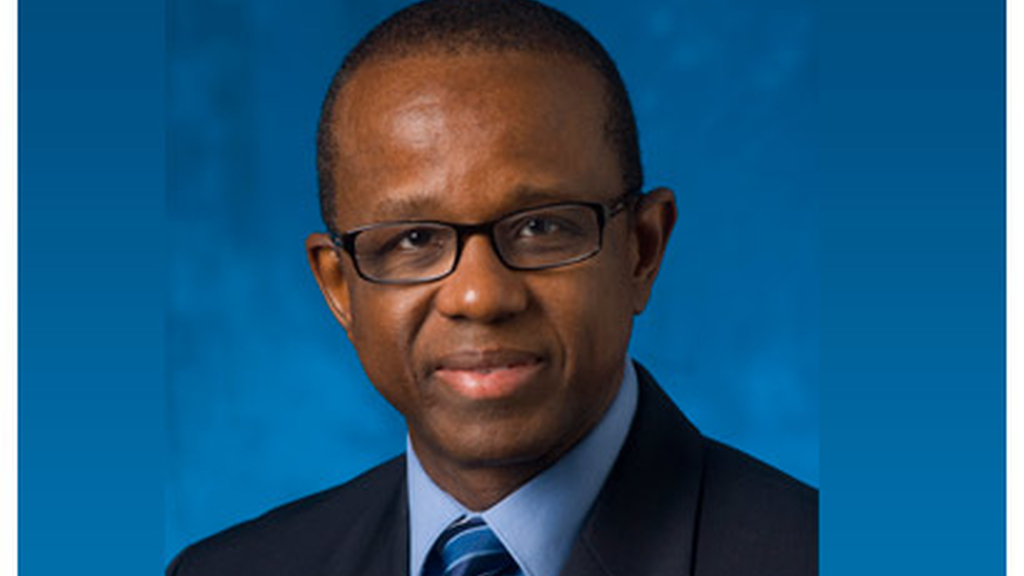
Secretary General of CTO: Critical role of the Caribbean in tourism
On Friday, October 5, 2018, at the Atlantis Resort, Paradise Island, in the Bahamas, the Secretary General of the Caribbean Tourism Organization, Hugh Riley, thanked the head table and other dignitaries and media for coming to the State of the Tourism Industry Conference (SOTIC) and delivered the following opening remarks at a news conference:
Let me first of all, publicly thank my colleague ministers for placing their faith in me by electing me on Tuesday as chairman of the Caribbean Tourism Organization. I’m humbled by their confidence, yet excited about the opportunity to help guide such an important regional institution for the next two years.
I’m also excited at the prospects for the CTO and the critical role it can play in unifying the Caribbean, not simply as a tourism destination, but as a people destined for greatness.
I’m convinced that a well-supported, well-funded, CTO can take its place alongside other venerable institutions to lift the people of the Caribbean to incredible heights that are attainable but not yet achieved.
The organization’s leadership in tourism and its contribution to the development of our human resources will help drive strong economies and build reliable, competent and productive workforces and Caribbean populations that are ready to face an ever-changing global environment.
The CTO’s leadership was on full display this week through the experts we brought together to share insights into how we can better build a lasting and sustainable tourism sector that will benefit every individual, every community, every country in this region.
We dared to challenge the region to build better, not just the infrastructure, but the entire industry. We explored applicable recommendations for the use of technology, not only to improve the visitors’ experience, but our lot as a people. We boldly tackled controversial issues such as commoditizing our cultures without exploiting them and embracing the Caribbean as a region of roots.
We brought these issues to the forefront not because they’re popular, but because we are convinced they must be successfully addressed sooner rather than later, if we are to truly build a Caribbean tourism industry for the future.
And there’s no better way to shape the future than to involve our young people. There isn’t a single person among those who were in the room for yesterday’s youth congress, or among the approximately three thousand people who watched it live on the CTO Facebook page, who will disagree with me when I say we have some of the most creative, imaginative and smartest young people anywhere.
They are the ones who will be challenged to continue building the tourism industry on the foundation that has been laid by today’s leaders and yesterday’s pioneers. Based on the strength of their performances yesterday, I’m confident that the future of tourism is bright.
In this context, allow me to congratulate the youth congress winner, Jamaica’s Bryanna Hylton, as well as St. Maarten’s Kiara Meyers and Caroline Pain of Martinique, who placed in the top three.
I know you’d also like an update on our The Rhythm Never Stops campaign; I’m happy to advise that the campaign will be launched this coming Monday, thanks to the public- and private sector stakeholders who contributed to this important first phase.
On the region’s tourism performance, it has been a tale of two situations. On the one hand, we have robust growth in countries that were not affected by last year’s hurricanes.
On the other, we have seen dramatic decreases in arrivals to those hit by the storms, although the performances of these countries are steadily improving.
Of the 22 reporting destinations, 13 of them registered increases in tourist arrivals during the first half of the year, ranging from 1.7 percent to 18.3, while seven recorded decreases of between a negligible -0.3 percent and 71 percent.
The top performing destination during this period were Guyana at 18.3 percent, Belize at 17.1 percent, the Cayman Islands at 15.9 percent, and Grenada at 10.7 percent and the Bahamas at 10.2 percent.
These individual results substantiate the regional messaging of the openness of the destinations for business and the confidence in destinations to deliver quality experiences.
The performances of the key source markets varied considerably, with some destinations recording strong growth, while others registered declines.
In the US market, for example, while Jamaica reported growth of 8.4 percent, the Dominican Republic was up by 6.3 percent and 11 other destinations achieved growth, six of which were by double digits, the Caribbean received Seven million visits from the US during the first half of the year.
This was a 15.8 percent decrease when compared to the corresponding period last year, due mainly to a 54.6 percent fall in arrivals to Puerto Rico and decreases in arrivals to Cuba.
On the other hand, there was a new record in arrivals from Canada for this time of year, with 2.4 million overnight international tourists, representing a 4.7 percent increase.
Arrivals from Europe also increased, though marginally at 0.3 percent, with three million tourists visiting the Caribbean during the first half of the year.
Belize led the way with 24.3 percent growth, followed by Guyana at 9.4% percent, Curaçao 6.2 percent and Saint Lucia at 4.5 percent. However, overall growth was impacted by steep falls in arrivals to Anguilla, Puerto Rico and Bermuda.
There was also a marginal decline of 0.5 percent in cruise visits, although there are signs of improvement. Of the 23 reporting destinations, 15 realized improvement upon their 2017 performances with Trinidad & Tobago registering increases of 166 percent, St. Vincent & the Grenadines up by 84 percent and Martinique at 54.7 percent, leading on growth rates.
However, this was countered by declines of nearly 90 percent in the British Virgin Islands, Dominica was down by 88.4 percent, St. Maarten down 27.5 percent, and the US Virgin Islands decreased by 22.5 percent. Puerto Rico, though hurricane-impacted, posted a 1.1 percent increase during the period.
The region’s competitive advantages of a diverse tourism product and safety and security are still intact. Destinations are rebuilding, and new tourism products and services are being restored daily in the destinations impacted by last year’s hurricanes.
Our research department anticipates an overall decline of between three and four percent this year, but predicts a 4.3 percent increase next year.
Cruise, on the other hand, is projected to grow by five percent to six percent this year.
Let me take the opportunity to thank Minister Dionisio D’Aguillar, director general Joy Jibrilu and team at the Bahamas ministry of tourism, as well as our own CTO staff for working so hard to pull off a wonderful State of the Tourism Industry conference, and I thank you for your participation.
